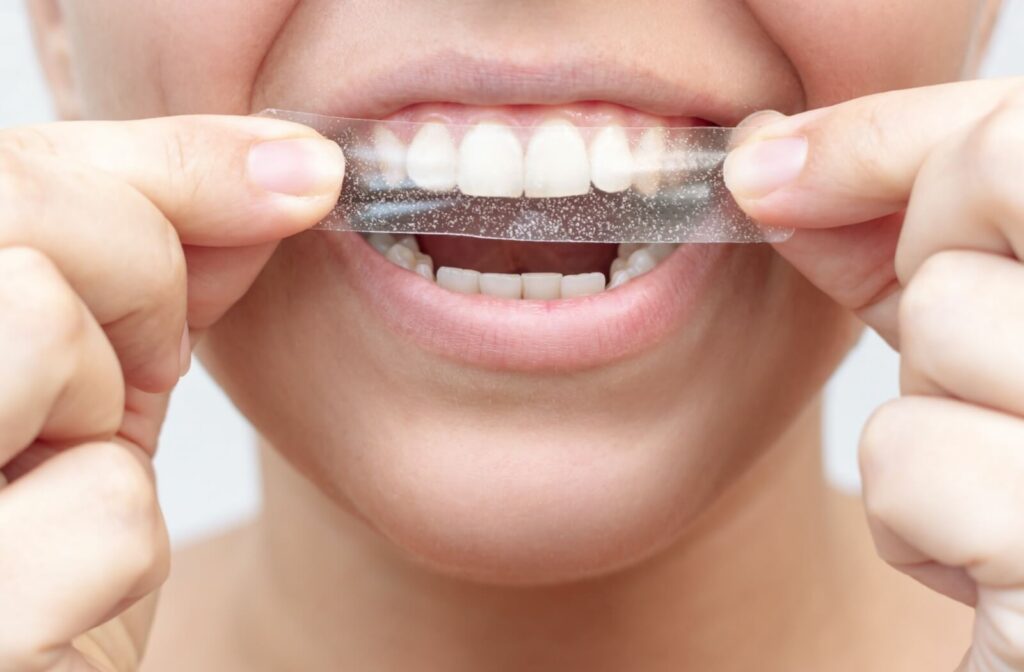A bright, white smile is often associated with good health and gives many of us some extra confidence. Many people turn to teeth whitening as an accessible way to enhance their appearance.
But amidst the pursuit of pearly whites, concerns regarding the safety of these treatments, particularly their impact on tooth enamel, have emerged. So, is it worth the risk to your enamel?
While these treatments can effectively whiten teeth, they can also cause sensitivity and weaken the enamel.
How Does Teeth Whitening Work?
Teeth whitening involves using bleaching agents that penetrate the enamel to break down stains.
Hydrogen peroxide or carbamide peroxide are commonly used in these treatments because they release oxygen molecules, which react with the discoloured molecules within the enamel, lifting the stains and resulting in a brighter smile.
The process can be performed professionally or at home, with varying concentrations of the active ingredients.
What Is Tooth Enamel?
First, let’s understand tooth enamel and why it’s important. Enamel is the hard outer layer of teeth that protects the underlying dentin and pulp. It acts as a protective barrier against bacteria, acids, and other harmful substances that can damage teeth.
Unlike other parts of our body, enamel cannot regenerate or repair itself once damaged. This makes it vital to preserve and protect our enamel to maintain healthy teeth.
Keep Enamel Healthy
To maintain strong and healthy enamel, it’s important to practice good oral hygiene habits such as brushing twice a day with fluoride toothpaste and flossing daily. Fluoride is essential for protecting enamel as it helps to remineralize and strengthen it.
It’s also important to limit your intake of acidic and sugary foods and drinks, which can erode enamel over time.
If you do consume these types of foods, be sure to rinse your mouth with water afterward and wait at least 30 minutes before brushing your teeth. This gives your saliva enough time to neutralize the acids in your mouth.
Common Teeth Whitening Methods
Professional In-Office Whitening
Professional whitening treatments are conducted by dental professionals who use high-concentration bleaching agents. These treatments are usually faster and more effective than at-home options.
Dentists also take precautions to protect the gums and enamel during the process, reducing the risk of damage.
At-Home Whitening Kits
At-home whitening kits, often prescribed by dentists, contain lower concentrations of bleaching agents. These kits typically include custom-fitted trays and detailed instructions for safe use.
While they require more time to achieve results than in-office treatments, they can still be quite effective.
Over-the-Counter Whitening Products
Over-the-counter (OTC) whitening products include strips, gels, and toothpaste. These products are widely accessible and generally contain even lower concentrations of bleaching agents.
While convenient, they may not provide the same level of effectiveness and safety as professional treatments or dentist-prescribed kits.
The Safety of Professional Whitening Treatments
Professional whitening treatments are designed with enamel safety in mind. Dentists use protective barriers to shield gums and carefully control the concentration and application of bleaching agents.
This professional oversight helps minimize the risk of enamel damage, making it a safer option for those concerned about their enamel health.
Risks of Overusing At-Home Whitening Products

Overuse or improper use of at-home whitening products can lead to several issues. High frequency and prolonged exposure to bleaching agents can cause:
- Enamel erosion
- Increased tooth sensitivity
- Gum irritation
Follow instructions meticulously and avoid the temptation to overuse these products in pursuit of quicker results.
Signs of Enamel Damage from Whitening
If you’re worried about potential enamel damage from teeth whitening, watch for these signs:
- Increased tooth sensitivity to hot, cold, or sweet foods and drinks.
- Visible thinning or translucency of the enamel.
- Chronic discomfort or pain in the teeth and gums.
Protecting Your Enamel During Whitening
To maintain enamel health while whitening your teeth, consider the following tips:
- Use whitening products as directed and avoid exceeding the recommended duration or frequency.
- Opt for professional treatments whenever possible to ensure safety and effectiveness.
- Maintain good oral hygiene practices, including using fluoride toothpaste to strengthen enamel.
- Limit consumption of acidic foods and drinks that can further erode enamel.
Alternative Ways to Brighten Your Smile
If you’re hesitant about traditional whitening methods, there are alternative ways to achieve a brighter smile:
- Regular professional cleanings to remove surface stains.
- Switching to whitening toothpaste with mild abrasives.
- Incorporating foods that naturally whiten teeth, like strawberries and apples, into your diet.
Consulting with Your Dentist
Before starting any whitening treatment, it’s important to consult with your dentist. They can assess your dental health, recommend the most appropriate whitening method, and provide personalized advice on protecting your enamel.
Dental professionals can also monitor your progress and address any concerns promptly.
Achieving a Bright Smile Safely
A whiter smile is attainable without compromising your enamel’s integrity. By understanding the science behind teeth whitening, choosing professional treatments, and following best practices, you can safely enjoy the benefits of a brighter smile without risking your enamel.
Always prioritize your dental health and seek professional guidance to ensure your enamel remains strong and healthy.
If you’re considering teeth whitening, don’t hesitate to book an appointment with Arch King West Dental to explore the best options for you.


